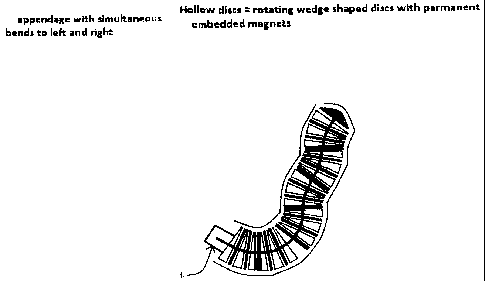Une partie des informations de ce site Web a été fournie par des sources externes. Le gouvernement du Canada n'assume aucune responsabilité concernant la précision, l'actualité ou la fiabilité des informations fournies par les sources externes. Les utilisateurs qui désirent employer cette information devraient consulter directement la source des informations. Le contenu fourni par les sources externes n'est pas assujetti aux exigences sur les langues officielles, la protection des renseignements personnels et l'accessibilité.
L'apparition de différences dans le texte et l'image des Revendications et de l'Abrégé dépend du moment auquel le document est publié. Les textes des Revendications et de l'Abrégé sont affichés :
| (12) Demande de brevet: | (11) CA 2773839 |
|---|---|
| (54) Titre français: | MANIPULATEUR MULTIUSAGE |
| (54) Titre anglais: | A MULTIPURPOSE MANIPULATOR |
| Statut: | Réputée abandonnée et au-delà du délai pour le rétablissement - en attente de la réponse à l’avis de communication rejetée |
| (51) Classification internationale des brevets (CIB): |
|
|---|---|
| (72) Inventeurs : |
|
| (73) Titulaires : |
|
| (71) Demandeurs : |
|
| (74) Agent: | |
| (74) Co-agent: | |
| (45) Délivré: | |
| (22) Date de dépôt: | 2012-03-30 |
| (41) Mise à la disponibilité du public: | 2013-09-30 |
| Requête d'examen: | 2014-03-03 |
| Licence disponible: | S.O. |
| Cédé au domaine public: | S.O. |
| (25) Langue des documents déposés: | Anglais |
| Traité de coopération en matière de brevets (PCT): | Non |
|---|
| (30) Données de priorité de la demande: | S.O. |
|---|
This Patent application is for a Multipurpose Manipulator which can duplicate
and exceed the
abilities of the human hand, as well as being able to mimic the versatility of
an octopus tentacle.
Many current designs are limited to simple "open and close" movements in only
one plane of
motion. This proposed design is an improvement on conventional manipulators as
it allows for
many planes of movement, as well as superior and controllable gripping
strength.
The basic design involves a series of rotatable, circular inclined planes
enclosed in a flexible outer
covering. Small electromagnets spin the circular "wedges" into different
configurations, thus
producing a powerful bending motion. A central cable temporarily "locks in"
the configuration.
The "Multipurpose Manipulator" is easily scaled up or down in size and the
strength and speed of
motion can be predesigned into the unit. It is well suited for such things as
enhanced prosthetics,
remotely controlled equipment, medical probes and construction equipment,
particularly those
involved in picking up, moving and releasing objects. lt is well suited for
robotic assembly line
work.
Note : Les revendications sont présentées dans la langue officielle dans laquelle elles ont été soumises.
Note : Les descriptions sont présentées dans la langue officielle dans laquelle elles ont été soumises.

2024-08-01 : Dans le cadre de la transition vers les Brevets de nouvelle génération (BNG), la base de données sur les brevets canadiens (BDBC) contient désormais un Historique d'événement plus détaillé, qui reproduit le Journal des événements de notre nouvelle solution interne.
Veuillez noter que les événements débutant par « Inactive : » se réfèrent à des événements qui ne sont plus utilisés dans notre nouvelle solution interne.
Pour une meilleure compréhension de l'état de la demande ou brevet qui figure sur cette page, la rubrique Mise en garde , et les descriptions de Brevet , Historique d'événement , Taxes périodiques et Historique des paiements devraient être consultées.
| Description | Date |
|---|---|
| Inactive : Morte - Aucune rép. dem. par.30(2) Règles | 2015-10-07 |
| Demande non rétablie avant l'échéance | 2015-10-07 |
| Requête visant le maintien en état reçue | 2015-01-23 |
| Inactive : Abandon. - Aucune rép dem par.30(2) Règles | 2014-10-07 |
| Inactive : Dem. de l'examinateur par.30(2) Règles | 2014-04-07 |
| Inactive : Rapport - Aucun CQ | 2014-04-03 |
| Lettre envoyée | 2014-03-17 |
| Requête d'examen reçue | 2014-03-03 |
| Requête visant le maintien en état reçue | 2014-03-03 |
| Toutes les exigences pour l'examen - jugée conforme | 2014-03-03 |
| Exigences pour une requête d'examen - jugée conforme | 2014-03-03 |
| Demande publiée (accessible au public) | 2013-09-30 |
| Inactive : Page couverture publiée | 2013-09-29 |
| Inactive : CIB attribuée | 2012-06-08 |
| Inactive : CIB attribuée | 2012-06-08 |
| Inactive : CIB en 1re position | 2012-06-08 |
| Inactive : CIB attribuée | 2012-06-08 |
| Inactive : Lettre officielle | 2012-04-25 |
| Inactive : Certificat de dépôt - Sans RE (Anglais) | 2012-04-25 |
| Demande reçue - nationale ordinaire | 2012-04-25 |
| Déclaration du statut de petite entité jugée conforme | 2012-03-30 |
Il n'y a pas d'historique d'abandonnement
Le dernier paiement a été reçu le 2015-01-23
Avis : Si le paiement en totalité n'a pas été reçu au plus tard à la date indiquée, une taxe supplémentaire peut être imposée, soit une des taxes suivantes :
Les taxes sur les brevets sont ajustées au 1er janvier de chaque année. Les montants ci-dessus sont les montants actuels s'ils sont reçus au plus tard le 31 décembre de l'année en cours.
Veuillez vous référer à la page web des
taxes sur les brevets
de l'OPIC pour voir tous les montants actuels des taxes.
| Type de taxes | Anniversaire | Échéance | Date payée |
|---|---|---|---|
| Taxe pour le dépôt - petite | 2012-03-30 | ||
| Requête d'examen - petite | 2014-03-03 | ||
| TM (demande, 2e anniv.) - petite | 02 | 2014-03-31 | 2014-03-03 |
| TM (demande, 3e anniv.) - petite | 03 | 2015-03-30 | 2015-01-23 |
Les titulaires actuels et antérieures au dossier sont affichés en ordre alphabétique.
| Titulaires actuels au dossier |
|---|
| DAVID O. STOREY |
| Titulaires antérieures au dossier |
|---|
| S.O. |